Microsoft Bundle
Who Really Owns Microsoft?
Ever wondered who pulls the strings at one of the world's most influential tech giants? Understanding Microsoft's SWOT analysis is just the beginning; knowing its ownership structure is key to grasping its future. From its humble beginnings to a multi-trillion-dollar valuation, Microsoft's ownership has undergone a fascinating transformation. Discover the key players and pivotal moments that have shaped the Microsoft company owner landscape.
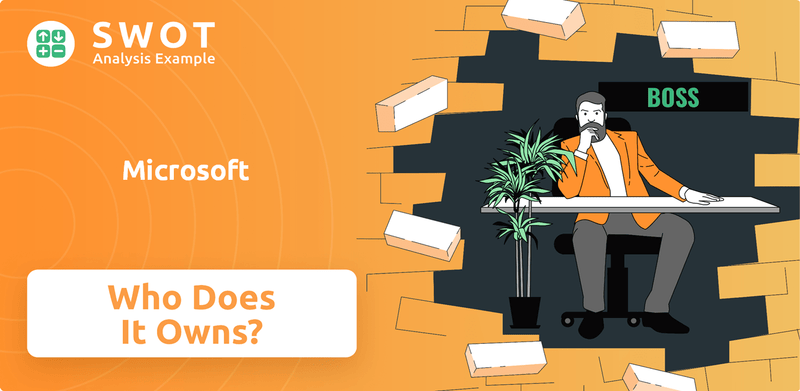
This exploration into Microsoft ownership delves beyond the headlines, examining the evolution of Microsoft shareholders and the influence of Microsoft executives. We'll uncover the roles of the Microsoft founder, major institutional investors, and the current board of directors, providing a comprehensive view of who controls Microsoft's decisions. Learn about the history of Microsoft's ownership and how it impacts the company's strategic direction and market performance.
Who Founded Microsoft?
The story of Microsoft begins with its founders, Bill Gates and Paul Allen, who established the company in 1975. Their initial vision was to bring software to personal computers, a concept that would revolutionize the tech industry. The early ownership structure was pivotal in shaping the company's direction and future growth.
Bill Gates and Paul Allen's collaboration was the cornerstone of Microsoft's early success. Gates, with his focus on software development, and Allen, who conceived the idea of software for the Altair 8800, formed a partnership that would define the personal computing era. Their combined efforts and strategic decisions set the stage for Microsoft's dominance.
The initial ownership split between Gates and Allen, although not precisely documented with exact percentages from the very beginning, reflected their respective contributions. Gates' larger stake was due to his key role in developing the BASIC interpreter, Microsoft's first major product. Allen, who played a crucial role in the company's formation, also held a significant share. Their early agreements were based on their responsibilities and contributions to the nascent company.
Unlike many startups, Microsoft didn't rely heavily on external investors in its early stages. Instead, the company was largely self-funded through its early revenues. This allowed Gates and Allen to retain significant control over the company's direction and equity. This approach helped them maintain a clear vision and unified purpose as they steered the company through its formative years.
- The founders' concentrated ownership enabled them to make swift decisions and adapt quickly to the evolving tech landscape.
- Early agreements likely included provisions for decision-making and profit-sharing, reflecting the collaborative yet distinct roles of the co-founders.
- There were no widely reported initial ownership disputes or buyouts in the very early stages that dramatically altered the founding equity split before the company's rapid growth.
- The founders' vision of widespread software adoption was directly reflected in their concentrated ownership, enabling them to steer the company with a clear and unified purpose.
Microsoft SWOT Analysis
- Complete SWOT Breakdown
- Fully Customizable
- Editable in Excel & Word
- Professional Formatting
- Investor-Ready Format
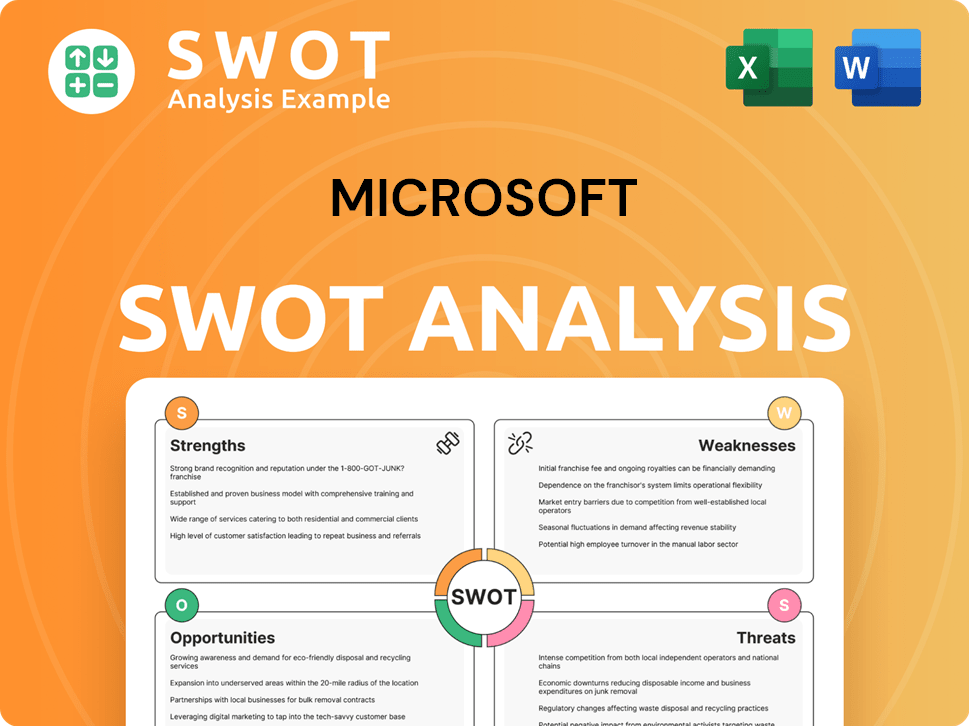
How Has Microsoft’s Ownership Changed Over Time?
The evolution of Microsoft ownership has been marked by key events, most notably its Initial Public Offering (IPO) on March 13, 1986. The IPO priced shares at $21, raising $61 million and establishing an initial market capitalization of approximately $779 million. This pivotal moment transformed the ownership structure, shifting from a concentration among founders and early employees to a broader base of public shareholders. The IPO was a significant step in Microsoft's journey, impacting its growth trajectory and governance model.
Following the IPO, Microsoft's ownership structure has been significantly influenced by the rise of institutional investors. The company's ownership has become increasingly dominated by these entities. The shift towards institutional ownership has reshaped the dynamics of corporate governance, with these large investors playing a crucial role in influencing strategic decisions and holding management accountable.
| Event | Date | Impact on Ownership |
|---|---|---|
| Initial Public Offering (IPO) | March 13, 1986 | Diversified ownership from founders and early employees to public shareholders. |
| Growth of Institutional Investors | Ongoing | Increased influence of large asset management firms and index funds. |
| Executive Stock Ownership | Ongoing | Alignment of management interests with shareholder value through stock-based compensation. |
As of early 2025, the major shareholders of Microsoft include prominent institutional investors like Vanguard Group Inc., BlackRock Inc., and State Street Corp. These firms collectively hold a substantial percentage of Microsoft's outstanding shares, often exceeding 20-25% combined. Individual insiders, such as current and former executives and board members, also hold significant stakes. For instance, Bill Gates, although no longer the largest individual shareholder, retains a notable position. Satya Nadella, the current CEO, also holds a significant number of shares. This distribution of ownership influences strategic decision-making and corporate governance, reflecting a balance between institutional influence and insider perspectives. The company is headquartered in Redmond, Washington, and employs over 221,000 people worldwide as of 2024.
The ownership of Microsoft has evolved significantly since its IPO, now primarily influenced by institutional investors.
- Major shareholders include Vanguard, BlackRock, and State Street.
- Bill Gates and Satya Nadella hold significant shares.
- The ownership structure impacts strategic decisions and corporate governance.
- The public does own Microsoft.
Microsoft PESTLE Analysis
- Covers All 6 PESTLE Categories
- No Research Needed – Save Hours of Work
- Built by Experts, Trusted by Consultants
- Instant Download, Ready to Use
- 100% Editable, Fully Customizable
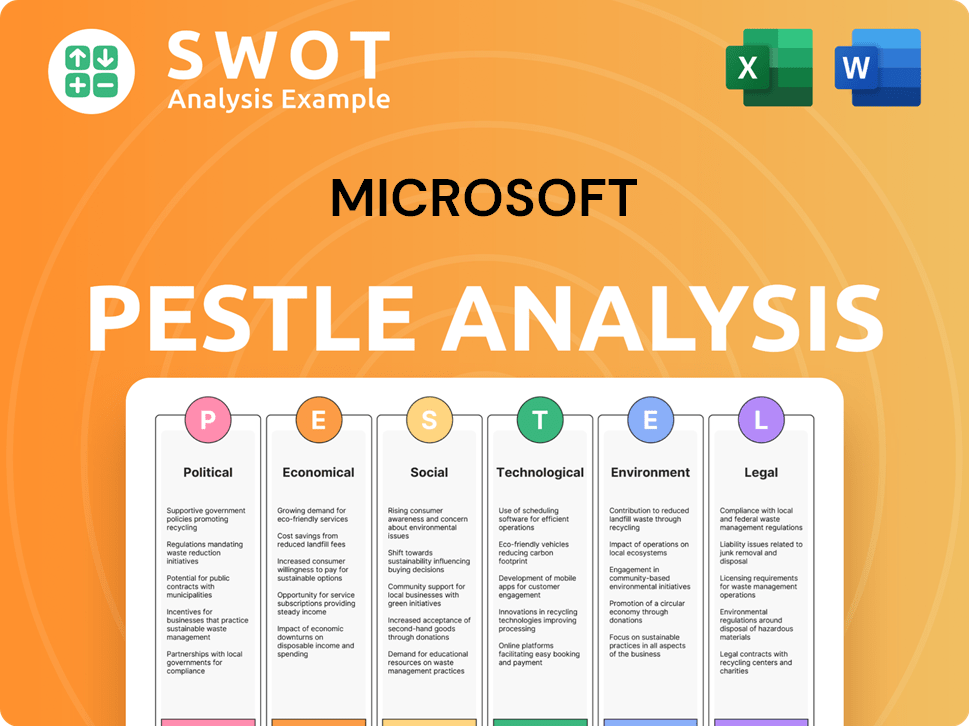
Who Sits on Microsoft’s Board?
The current board of directors at the company includes a mix of independent directors and key executives, reflecting a commitment to corporate governance and diverse expertise. As of early 2025, the board includes members such as Satya Nadella, who serves as Chairman and CEO, alongside independent directors from various professional backgrounds. This structure ensures a balance of perspectives in guiding the company's strategic direction. The board's composition is designed to provide oversight and expertise in key areas, supporting the long-term success of the company.
While specific board seats aren't directly allocated to represent major individual shareholders in the traditional sense, the influence of large institutional investors is often felt through engagement with the board and proxy voting. The board's responsibilities include overseeing the company's strategy, risk management, and executive leadership. The board's structure and the company's governance practices are designed to promote accountability and transparency, ensuring that the interests of all shareholders are considered in decision-making processes. Understanding Revenue Streams & Business Model of Microsoft can also provide valuable insights into the company's overall strategy and operations.
| Board Member | Title | Affiliation |
|---|---|---|
| Satya Nadella | Chairman and CEO | Microsoft |
| John W. Thompson | Lead Independent Director | Microsoft |
| Emma Walmsley | Independent Director | Microsoft |
The company operates primarily on a one-share-one-vote structure. This means each share of common stock generally entitles its holder to one vote on matters brought before shareholders, such as the election of directors and approval of corporate actions. There are no known dual-class shares, golden shares, or other special voting rights that grant outsized control to any specific individual or entity beyond their proportional shareholding. This structure promotes a more equitable distribution of voting power among all shareholders, ensuring that decision-making is influenced by a broad base of shareholders, with a focus on long-term value creation. The company's commitment to this structure reflects its dedication to fair governance practices.
The company's board of directors includes both company executives and independent directors. This structure promotes a balance of perspectives and expertise in guiding the company's strategy. The company operates on a one-share-one-vote structure, ensuring equitable voting power among all shareholders.
- Microsoft ownership is primarily held by institutional investors and the public.
- Microsoft shareholders influence decisions through voting rights.
- The company's governance structure supports long-term value creation.
- Microsoft executives play key roles in the company's leadership and strategy.
Microsoft Business Model Canvas
- Complete 9-Block Business Model Canvas
- Effortlessly Communicate Your Business Strategy
- Investor-Ready BMC Format
- 100% Editable and Customizable
- Clear and Structured Layout
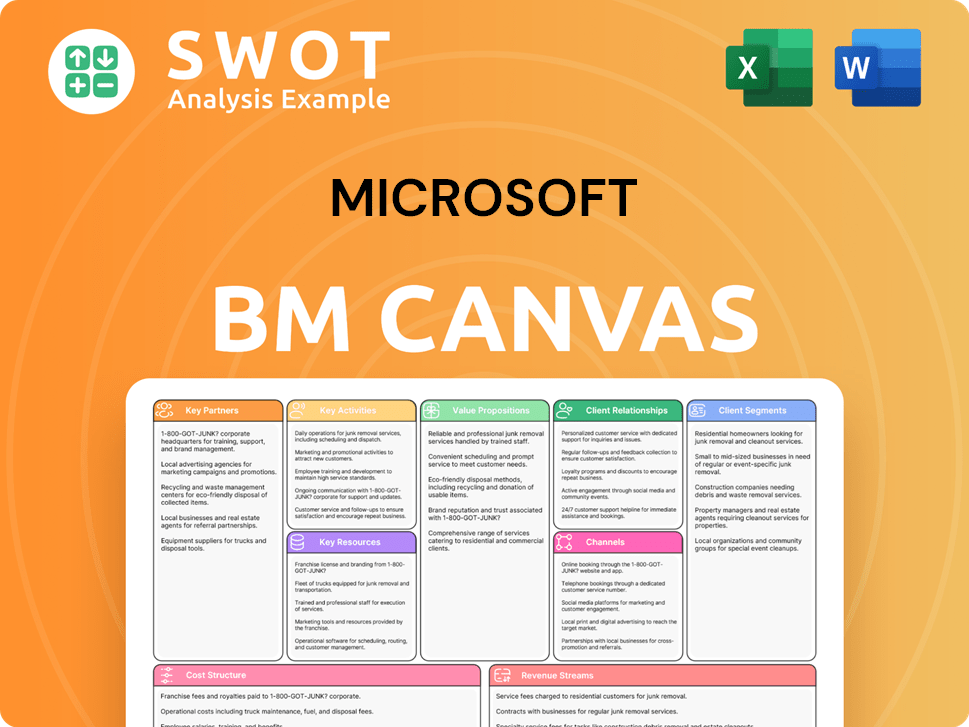
What Recent Changes Have Shaped Microsoft’s Ownership Landscape?
Over the past few years, the ownership structure of the Microsoft company has seen some notable shifts. A key element has been the consistent execution of share buyback programs. For instance, in 2021, Microsoft authorized a share repurchase program of up to $60 billion. These programs are designed to return value to Microsoft shareholders and decrease the total number of outstanding shares, thus influencing the proportional ownership of existing shareholders. Additionally, the acquisition of Activision Blizzard, completed in October 2023 for approximately $69 billion, while not directly changing the ownership structure, significantly impacted the company's strategic direction and asset base.
Another significant trend is the increasing influence of institutional investors, particularly through passive index funds. This often leads to a more stable shareholder base focused on long-term market performance. Furthermore, the ownership percentage of Microsoft founder Bill Gates has gradually decreased over time due to the natural dilution that occurs with growth and public trading, although he remains a significant figure. Leadership changes, such as Satya Nadella taking on the role of Chairman in 2021, also play a role in shaping investor confidence and the company's direction. These factors collectively contribute to the evolving landscape of Microsoft ownership.
| Metric | Details | Recent Data |
|---|---|---|
| Market Capitalization | Total value of outstanding shares | Approximately $3.3 trillion (as of May 2024) |
| Institutional Ownership | Percentage of shares held by institutions | Around 70% (as of Q1 2024) |
| Share Repurchases | Value of shares bought back by the company | $16.8 billion in fiscal year 2024 |
The evolution of Microsoft's ownership structure reflects a blend of strategic financial decisions and broader market trends. The company's focus on long-term shareholder value is evident in its consistent share buybacks and strategic investments, as highlighted in this article about the Growth Strategy of Microsoft.
Microsoft's ownership is primarily held by institutional investors. These include large investment firms, mutual funds, and other financial entities. The public also owns a significant portion of the company through shares traded on the stock market.
Major shareholders include institutional investors such as The Vanguard Group, BlackRock, and State Street Corporation. Bill Gates, the Microsoft founder, remains a significant individual shareholder. Understanding who owns Microsoft is crucial.
Microsoft executives, including the CEO and board members, influence the company's strategic direction. Their decisions impact investor confidence and the company's overall performance. The executives' decisions influence how Microsoft is structured.
Microsoft's ownership structure is subject to change due to share buybacks, acquisitions, and market dynamics. These shifts reflect the company's commitment to shareholder value and its strategic growth initiatives. The public does own Microsoft.
Microsoft Porter's Five Forces Analysis
- Covers All 5 Competitive Forces in Detail
- Structured for Consultants, Students, and Founders
- 100% Editable in Microsoft Word & Excel
- Instant Digital Download – Use Immediately
- Compatible with Mac & PC – Fully Unlocked
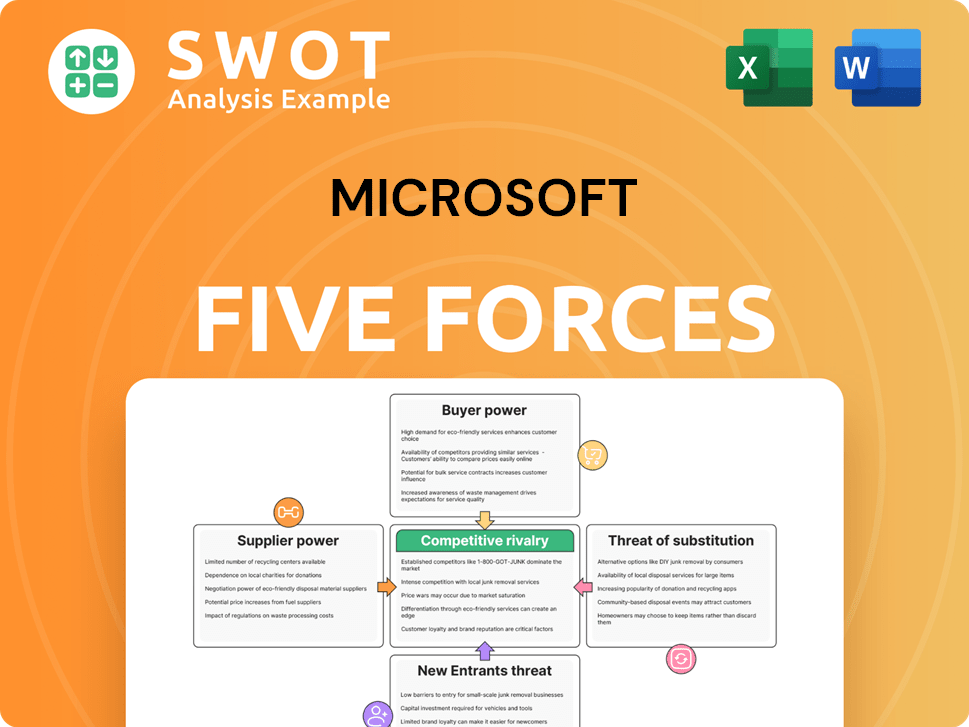
Related Blogs
- What are Mission Vision & Core Values of Microsoft Company?
- What is Competitive Landscape of Microsoft Company?
- What is Growth Strategy and Future Prospects of Microsoft Company?
- How Does Microsoft Company Work?
- What is Sales and Marketing Strategy of Microsoft Company?
- What is Brief History of Microsoft Company?
- What is Customer Demographics and Target Market of Microsoft Company?
Disclaimer
All information, articles, and product details provided on this website are for general informational and educational purposes only. We do not claim any ownership over, nor do we intend to infringe upon, any trademarks, copyrights, logos, brand names, or other intellectual property mentioned or depicted on this site. Such intellectual property remains the property of its respective owners, and any references here are made solely for identification or informational purposes, without implying any affiliation, endorsement, or partnership.
We make no representations or warranties, express or implied, regarding the accuracy, completeness, or suitability of any content or products presented. Nothing on this website should be construed as legal, tax, investment, financial, medical, or other professional advice. In addition, no part of this site—including articles or product references—constitutes a solicitation, recommendation, endorsement, advertisement, or offer to buy or sell any securities, franchises, or other financial instruments, particularly in jurisdictions where such activity would be unlawful.
All content is of a general nature and may not address the specific circumstances of any individual or entity. It is not a substitute for professional advice or services. Any actions you take based on the information provided here are strictly at your own risk. You accept full responsibility for any decisions or outcomes arising from your use of this website and agree to release us from any liability in connection with your use of, or reliance upon, the content or products found herein.